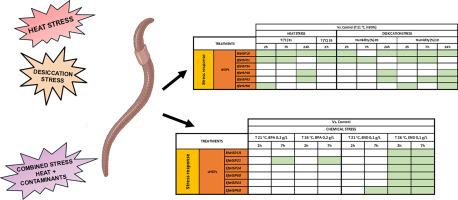Small heat shock proteins as relevant biomarkers for anthropogenic stressors in earthworms
IF 2.1
3区 生物学
Q4 BIOCHEMISTRY & MOLECULAR BIOLOGY
Comparative Biochemistry and Physiology A-Molecular & Integrative Physiology
Pub Date : 2024-11-23
DOI:10.1016/j.cbpa.2024.111785
引用次数: 0
Abstract
Anthropogenic stressors in terrestrial ecosystems require focused research on adaptive responses in soil organisms such as Eisenia fetida, a model earthworm species. We analyzed the gene expression of five small heat shock proteins (sHSPs) in response to various stressors: heat stress (31 and 35 °C), desiccation (10 % and 20 % humidity), and chemical exposure (bisphenol A and endosulfan) under standard and elevated temperatures. Under moderate heat (31 °C), early upregulation of sHSP transcripts suggests their involvement in initial stress responses, possibly mitigating protein aggregation. At the higher temperature (35 °C), three sHSPs served as a defense against severe protein aggregation, a significant finding as previous studies identified only one activated heat shock protein (HSP70) in E. fetida under similar conditions. Desiccation stress at 10 % humidity activated more sHSPs than at 20 % humidity, and the expression profile at 10 % humidity closely resembled that observed under heat stress, suggesting overlapping adaptation pathways. Heat combined with chemical stress, particularly endosulfan, elevated sHSP transcription and underscored the potential of these proteins as biomarkers in multi-stressor environments. Monomeric sHSPs from E. fetida, which share homology with human sHSPs, showed the highest activity across all stressors, suggesting their key role in earthworm adaptation.

小热休克蛋白作为蚯蚓人为压力的相关生物标志物
陆地生态系统中的人为胁迫因素要求对土壤生物的适应性反应进行重点研究,例如蚯蚓模型物种埃森藻(Eisenia fetida)。我们分析了五种小型热休克蛋白(sHSPs)的基因表达对各种应激源的响应:热应激(31 和 35 °C)、干燥(10 % 和 20 % 湿度)以及标准温度和高温下的化学暴露(双酚 A 和硫丹)。在中度高温(31 °C)条件下,sHSP 转录本的早期上调表明它们参与了最初的应激反应,可能缓解了蛋白质的聚集。在较高温度(35 °C)下,有三种热休克蛋白可抵御严重的蛋白质聚集,这是一个重大发现,因为之前的研究发现在类似条件下胎生动物体内只有一种活化的热休克蛋白(HSP70)。湿度为 10% 的干燥胁迫比湿度为 20% 的干燥胁迫激活了更多的 sHSPs,湿度为 10% 的干燥胁迫下的表达谱与热胁迫下观察到的表达谱非常相似,这表明存在重叠的适应途径。热胁迫与化学胁迫(尤其是硫丹)相结合,提高了 sHSP 的转录,凸显了这些蛋白质在多重胁迫环境中作为生物标志物的潜力。来自E. fetida的单体sHSP与人类的sHSP具有同源性,在所有胁迫条件下都表现出最高的活性,这表明它们在蚯蚓的适应过程中起着关键作用。
本文章由计算机程序翻译,如有差异,请以英文原文为准。
求助全文
约1分钟内获得全文
求助全文
来源期刊
CiteScore
5.00
自引率
4.30%
发文量
155
审稿时长
3 months
期刊介绍:
Part A: Molecular & Integrative Physiology of Comparative Biochemistry and Physiology. This journal covers molecular, cellular, integrative, and ecological physiology. Topics include bioenergetics, circulation, development, excretion, ion regulation, endocrinology, neurobiology, nutrition, respiration, and thermal biology. Study on regulatory mechanisms at any level of organization such as signal transduction and cellular interaction and control of behavior are also published.

 求助内容:
求助内容: 应助结果提醒方式:
应助结果提醒方式:


